Sunndalsøra
![]() Sunndalsøra is the administrative centre of Sunndal Municipality in Møre og Romsdal county, Norway. The village of Sunndalsøra lies at the mouth of the river Driva at the beginning of the Sunndalsfjorden. Sunndalsøra is surrounded by steep mountains, such as Hårstadnebba, which reach elevations as high as 1,700 metres (5,600 ft). Some of these mountains around Sunndalsøra are used for BASE jumping.
Sunndalsøra is the administrative centre of Sunndal Municipality in Møre og Romsdal county, Norway. The village of Sunndalsøra lies at the mouth of the river Driva at the beginning of the Sunndalsfjorden. Sunndalsøra is surrounded by steep mountains, such as Hårstadnebba, which reach elevations as high as 1,700 metres (5,600 ft). Some of these mountains around Sunndalsøra are used for BASE jumping.
Sunndalsøra | |
|---|---|
Village | |
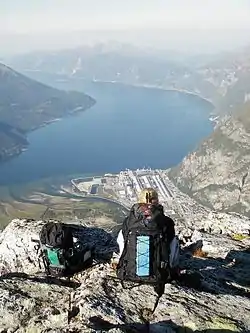 Sunndalsøra viewed from the mountain Litlkalkinn. The estuary of the river Driva is clearly visible, as is the aluminium plant. The Sunndalsfjord stretches out to northwest towards Kristiansund | |
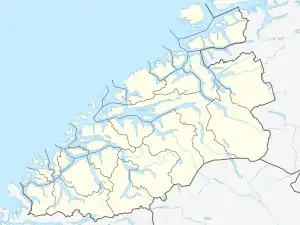 Sunndalsøra Location in Møre og Romsdal 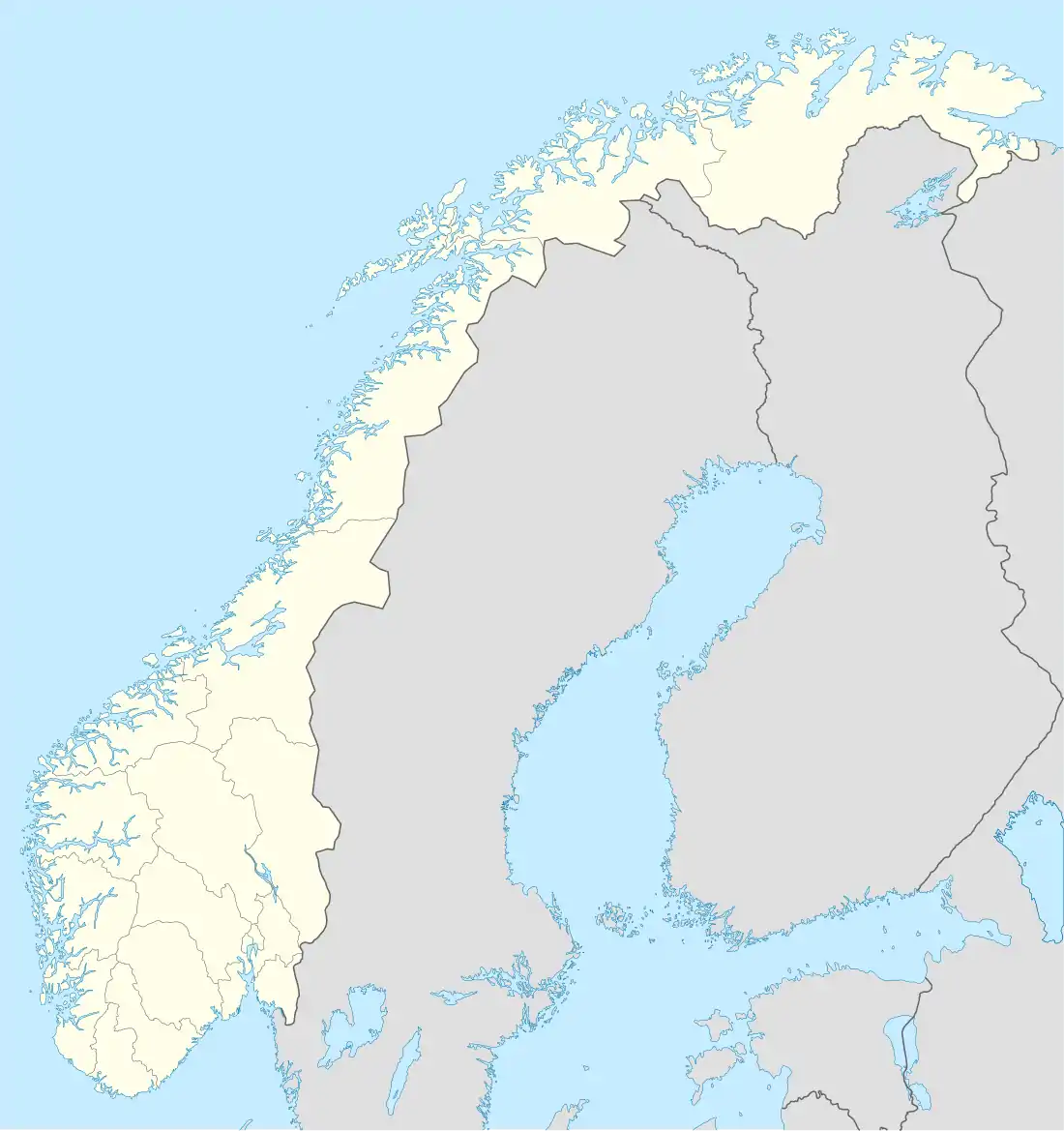 Sunndalsøra Sunndalsøra (Norway) | |
| Coordinates: 62.6752°N 8.5633°E | |
| Country | Norway |
| Region | Western Norway |
| County | Møre og Romsdal |
| District | Nordmøre |
| Municipality | Sunndal Municipality |
| Area | |
| • Total | 3.39 km2 (1.31 sq mi) |
| Elevation | 6 m (20 ft) |
| Population (2018)[1] | |
| • Total | 4,054 |
| • Density | 1,196/km2 (3,100/sq mi) |
| Time zone | UTC+01:00 (CET) |
| • Summer (DST) | UTC+02:00 (CEST) |
| Post Code | 6600 Sunndalsøra |
The 3.39-square-kilometre (840-acre) village has a population (2018) of 4,054 and a population density of 1,196 inhabitants per square kilometre (3,100/sq mi).[1]
Location
The village is located about 4 kilometres (2.5 mi) west of the village of Hoelsand, 10 kilometres (6.2 mi) southeast of the village of Øksendalsøra, and about 9 kilometres (5.6 mi) west of the village of Grøa. Norwegian National Road 70 runs through the village of Sunndalsøra on its way from the town of Kristiansund to Oppdal Municipality in the neighboring Trøndelag county.
Economy
Sunndalsøra is the largest village in Sunndal Municipality and it is home to Hov Church, the main church for the parish. Norsk Hydro operates an aluminium plant at Sunndalsøra. About 900 employees work at the plant, which has been operating since 1954. In 2004, the plant was modernized to become the biggest and among the most modern aluminium plants in Europe, greatly reducing pollution. In addition to aluminium related research, aquaculture research also takes place in Sunndalsøra, and many also work in public service in Sunndal municipality.[3]
Climate
Sunndalsøra is well known in Norway for occasional extreme warm winter temperatures. This is due to the mountains surrounding the fjord and the town, creating a foehn warming with the right weather setup: A strong low located southwest of the coast brings mild air from the Atlantic Ocean and the air is further warmed by the foehn. Sunndalsøra has the national all-time high for all winter months: December with 18.3 °C (64.9 °F) recorded in 1998, January with 19.0 °C (66.2 °F), recorded January 2, 2020. This is also the warmest winter temperature ever recorded in Scandinavia. And in February with 18.9 °C (66.0 °F) recorded February 23, 1990.[4]
| Climate data for Sunndalsøra | |||||||||||||
|---|---|---|---|---|---|---|---|---|---|---|---|---|---|
| Month | Jan | Feb | Mar | Apr | May | Jun | Jul | Aug | Sep | Oct | Nov | Dec | Year |
| Record high °C (°F) | 19.0 (66.2) |
18.9 (66.0) |
18.4 (65.1) |
22.2 (72.0) |
28.1 (82.6) |
31.2 (88.2) |
32.1 (89.8) |
31.7 (89.1) |
27.6 (81.7) |
25 (77) |
21.6 (70.9) |
18.3 (64.9) |
32.1 (89.8) |
| Average high °C (°F) | 2 (36) |
3 (37) |
4 (39) |
9 (48) |
13 (55) |
16 (61) |
18 (64) |
17 (63) |
14 (57) |
9 (48) |
5 (41) |
3 (37) |
9 (49) |
| Average low °C (°F) | −2 (28) |
−2 (28) |
−1 (30) |
2 (36) |
6 (43) |
9 (48) |
12 (54) |
11 (52) |
8 (46) |
4 (39) |
1 (34) |
−1 (30) |
4 (39) |
| Record low °C (°F) | −16.6 (2.1) |
−18.9 (−2.0) |
−16 (3) |
−6.3 (20.7) |
−1 (30) |
0.7 (33.3) |
4 (39) |
0.9 (33.6) |
−1.5 (29.3) |
−7.3 (18.9) |
−11.4 (11.5) |
−16.7 (1.9) |
−18.9 (−2.0) |
| Average precipitation mm (inches) | 77 (3.0) |
62 (2.4) |
72 (2.8) |
55 (2.2) |
51 (2.0) |
60 (2.4) |
89 (3.5) |
86 (3.4) |
112 (4.4) |
102 (4.0) |
93 (3.7) |
102 (4.0) |
961 (37.8) |
| Average precipitation days | 10 | 9 | 10 | 9 | 8 | 11 | 13 | 13 | 14 | 12 | 11 | 13 | 133 |
| Source 1: Storm.no[5] | |||||||||||||
| Source 2: Eklima/met.no[6] | |||||||||||||
Media gallery
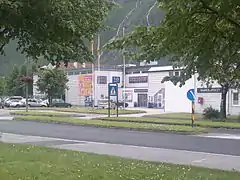 Rema 1000 in Sunndalsøra
Rema 1000 in Sunndalsøra


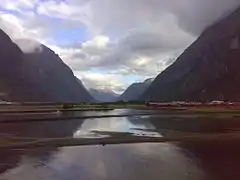 Looking towards the village from the fjord
Looking towards the village from the fjord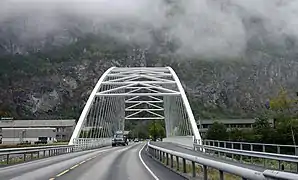 Bridge in Sunndalsøra
Bridge in Sunndalsøra
References
- Statistisk sentralbyrå (1 January 2018). "Urban settlements. Population and area, by municipality".
- "Sunndalsøra, Sunndal (Møre og Romsdal)". yr.no. Retrieved 2019-04-27.
- Store norske leksikon. "Sunndalsøra" (in Norwegian). Retrieved 2013-04-25.
- https://www.bbc.co.uk/news/world-europe-50971446
- "Sunndalsøra average conditions; base period 10 last years". Storm Weather Center. Retrieved 17 September 2016.
- "Eklima/met.no database". Norwegian Meteorological Institute. Retrieved 17 September 2016.